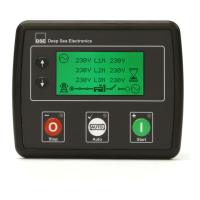Specification
14
3.8.2.3 FUEL LEVEL SENSOR
Measurement Type
Resistance measurement by measuring voltage across sensor with
a fixed current applied
Arrangement Differential resistance measurement input
Measurement Current 11mA ±10%
Full Scale
480Ω
Over Range / Fail
540Ω
Resolution 1%
Accuracy
+/-2% of full scale resistance (±9.6Ω) excluding transducer error
Max Common Mode Voltage ±2V
Display Range 0% - 250% subject to limits of the sensor
3.8.2.4 FLEXIBLE SENSOR (WHEN CONFIGURED)
Number 1 when Fuel Level Sender is configured as a flexible
Measurement Type
Resistance measurement by measuring voltage across sensor with
a fixed current applied
Arrangement Differential resistance measurement input
Measurement Current 11mA ±10%
Full Scale
480Ω
Over Range / Fail
540Ω
Resolution 1%
Accuracy
+/-2% of full scale resistance (±9.6Ω) excluding transducer error
Max Common Mode Voltage ±2V
Display Range
0% - 250%, 0°C - 250°C (32°F - 482°F) or 0 bar - 17.2 bar (0PSI -
250PSI)subject to limits of the sensor and sensor configuration
3.8.3 CHARGE FAIL INPUT
Minimum Voltage 0V
Maximum Voltage 35V (plant supply)
Resolution 0.2V
Accuracy ± 1% of max measured voltage
Excitation Active circuit constant power output
Output Power 2.5W nominal at 12V and 24V
Current At 12V 210mA
Current At 24V 105mA
The charge fail input is actually a combined input and output. Whenever the generator is required to
run, the terminal provides excitation current to the charge alternator field winding.
When the charge alternator is correctly charging the battery, the voltage of the terminal is close to
the plant battery supply voltage. In a failed charge situation, the voltage of this terminal is pulled
down to a low voltage. It is this drop in voltage that triggers the charge failure alarm. The level at
which this operates and whether this triggers a warning or shutdown alarm is configurable using the
DSE Configuration Suite Software.

